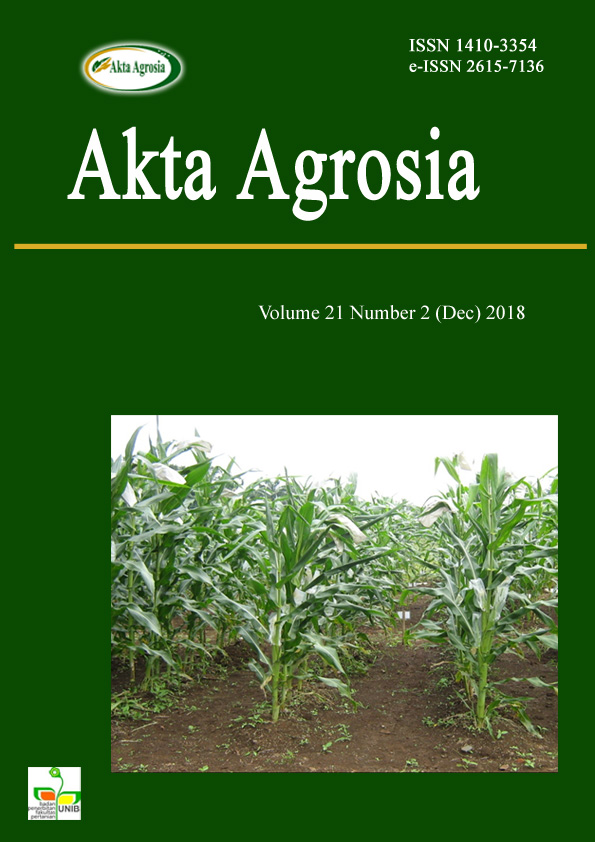Main Article Content
Abstract
Elaeisponic is new introducing growing technique to produce vegetables by planting it in the frond based of oil palm trees (Elaeis guineensis Jacq.). However, there was no previous report on vegetable production by using elaeisponic production system, including the use of foliar fertilizers. This study aimed to determine the optimum consentrations and frequency of foliar fertilization for caisim grown in elaesisponic production system. An experiment was conducted in oil palm plantation area by using a factorial randomized complete block design with three replicates. The first factor of treatment consisted of three levels of foliar fertilizer concentration, 1 g l-1, 2 g l-1 and 3 g l-1, and the second factor was application frequency of foliar fertilizer, 7 days after transplanting (DAT), 7, 14 DAT and 7, 14, 21 DAT. Crop responses were determined on leaf greenness (SPAD index), shoot fresh weight (g), root fresh weight (g), leaf area (cm2) and plant dry weight. Results indicated that both concentration of foliar fertilizer and frequency of application as wells as its interaction did not significatly affect leaf greenness, leaf area, shoot fresh weight, root fresh weight and plant dry weight of caisim plants. Further research should be addressed on optimizing the use of palm oil frond bases as growing medium for vegetable production.
Keywords: Elaeisponic Production System; Brassica juncea L; Foliar Fertilizer; Frequency of Application.
Article Details
Copyright (c) 2018 Yusrian S.O. Yanda, Fahrurrozi Fahrurrozi, Supanjani Supanjani

This work is licensed under a Creative Commons Attribution-ShareAlike 4.0 International License.
Authors who publish with this journal agree to the following terms:
- Authors retain copyright and grant the journal right of first publication with the work simultaneously licensed under a Creative Commons Attribution License that allows others to share the work with an acknowledgement of the work's authorship and initial publication in this journal.
- Authors are able to enter into separate, additional contractual arrangements for the non-exclusive distribution of the journal's published version of the work (e.g., post it to an institutional repository or publish it in a book), with an acknowledgement of its initial publication in this journal.
- Authors are permitted and encouraged to post their work online (e.g. in institutional repositories or on their website) prior to and during the submission process, as it can lead to productive exchanges, as well as earlier and greater citation of published work (See The Effect of Open Access).
References
- Decoteau, D.R. 2000. Vegetable Crops. Prentice Hall. Upper Saddle River, NJ.
- Haryanti, S. 2010. Pengaruh naungan yang berbeda terhadap jumlah stomata dan ukuran porus stomata daun Zephyranthes Rosea Lindl. Buletin Anatomi dan Fisiologi. 18 (1) : 41-48
- Haytova, D. 2013. A review of foliar fertilization of some vegetable crops. Annual Review and Research in Biology. (4):455-465.
- Holloway, P.J. and D. Stock. 1990. Factors affecting the activation of foliar uptake of agrochemicals by surfactants. In: D.S. Karsa (ed.), Industrial application of surfactants II. London, Royal Society of Chemistry. Special publication. 77:303-337.
- Karamoy, L.T. 2009. Hubungan iklim dengan pertumbuhan kedelai (Glycine max L Merrill). Soil Environment 7: 65-68.
- Marschner, H. 2012. Marschner’s Mineral Nutrition of Higher Plants. 3rd ed. London. Academic Press.
- Nasution, A.S., S.S. Awalluddin dan Muhammad. 2014. Pemberian pupuk ABG (Amazing Bio Growth) dan pupuk kompos terhadap pertumbuhan dan produksi tanaman sawi hijau (Brassica juncea L.). Jurnal Agrium. 18(3):260-268.
- Nilsen, E.T. and D.M. Orcutt. 1996. Physiology of Plants Under Stress. Abiotic Factors. John Wiley and Sons. New York. 689 pages.
- Novizan. 2002. Petunjuk Pemupukan yang Efektif. Agromedia Pustaka, Jakarta.
- Nurshanti, D.F. 2010. Pertumbuhan dan produksi tanaman sawi (Brassica juncea L.) dengan tiga varietas berbeda. Jurnal Agroekoteknologi. 2(4):41-54
- Pusat Penelitian Kelapa Sawit. 2014. Sertifikasi analisis hasil uji pupuk organik padat PT Bio Teknologi Bengkulu Tengah. Medan.
- Ramadiani, F.L. dan A.D. Susila. 2014. Sumber dan frekuensi aplikasi larutan hara sebagai pengganti AB Mix pada budidaya sayuran daun secara hidroponik. Jurnal Hortikultura Indonesia 5(1):34-46.
- Taiz, L. and E. Zeiger. 2010. Plant Physiology. 5th Ed. Sinauer Associate Sunderland
- Telaumbanua, M., P. Bambang., S. Lilik., A.F.F. Muhammad. 2016. Studi pola pertumbuhan tanaman sawi (Brassica rapa var. parachinensis L.) hidroponik di dalam greenhouse terkontrol. Jurnal Agritech 36(1):104-110.
References
Decoteau, D.R. 2000. Vegetable Crops. Prentice Hall. Upper Saddle River, NJ.
Haryanti, S. 2010. Pengaruh naungan yang berbeda terhadap jumlah stomata dan ukuran porus stomata daun Zephyranthes Rosea Lindl. Buletin Anatomi dan Fisiologi. 18 (1) : 41-48
Haytova, D. 2013. A review of foliar fertilization of some vegetable crops. Annual Review and Research in Biology. (4):455-465.
Holloway, P.J. and D. Stock. 1990. Factors affecting the activation of foliar uptake of agrochemicals by surfactants. In: D.S. Karsa (ed.), Industrial application of surfactants II. London, Royal Society of Chemistry. Special publication. 77:303-337.
Karamoy, L.T. 2009. Hubungan iklim dengan pertumbuhan kedelai (Glycine max L Merrill). Soil Environment 7: 65-68.
Marschner, H. 2012. Marschner’s Mineral Nutrition of Higher Plants. 3rd ed. London. Academic Press.
Nasution, A.S., S.S. Awalluddin dan Muhammad. 2014. Pemberian pupuk ABG (Amazing Bio Growth) dan pupuk kompos terhadap pertumbuhan dan produksi tanaman sawi hijau (Brassica juncea L.). Jurnal Agrium. 18(3):260-268.
Nilsen, E.T. and D.M. Orcutt. 1996. Physiology of Plants Under Stress. Abiotic Factors. John Wiley and Sons. New York. 689 pages.
Novizan. 2002. Petunjuk Pemupukan yang Efektif. Agromedia Pustaka, Jakarta.
Nurshanti, D.F. 2010. Pertumbuhan dan produksi tanaman sawi (Brassica juncea L.) dengan tiga varietas berbeda. Jurnal Agroekoteknologi. 2(4):41-54
Pusat Penelitian Kelapa Sawit. 2014. Sertifikasi analisis hasil uji pupuk organik padat PT Bio Teknologi Bengkulu Tengah. Medan.
Ramadiani, F.L. dan A.D. Susila. 2014. Sumber dan frekuensi aplikasi larutan hara sebagai pengganti AB Mix pada budidaya sayuran daun secara hidroponik. Jurnal Hortikultura Indonesia 5(1):34-46.
Taiz, L. and E. Zeiger. 2010. Plant Physiology. 5th Ed. Sinauer Associate Sunderland
Telaumbanua, M., P. Bambang., S. Lilik., A.F.F. Muhammad. 2016. Studi pola pertumbuhan tanaman sawi (Brassica rapa var. parachinensis L.) hidroponik di dalam greenhouse terkontrol. Jurnal Agritech 36(1):104-110.
